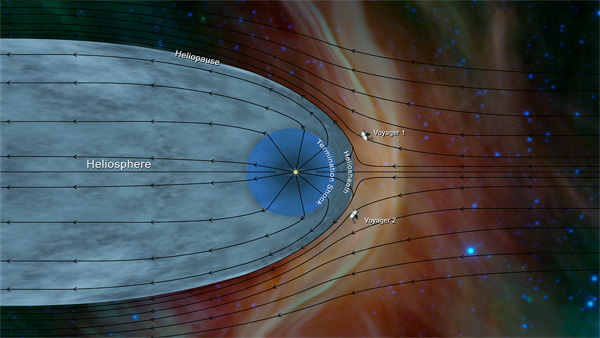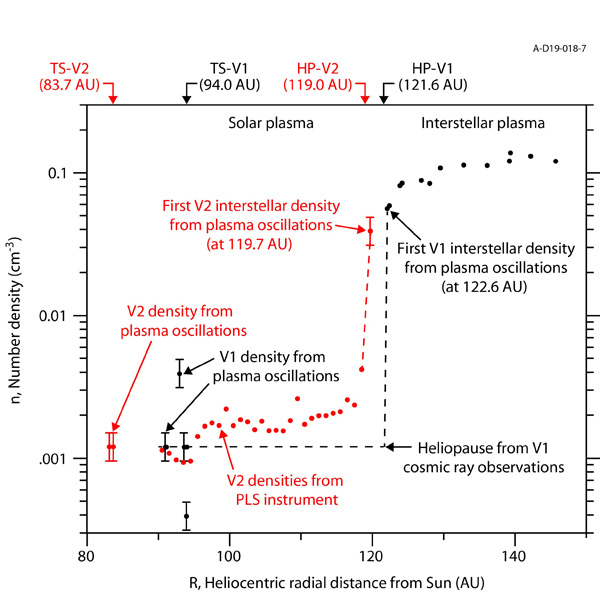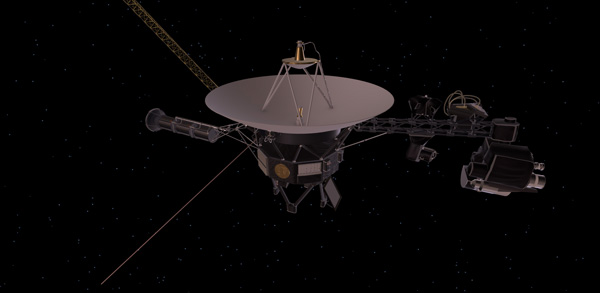Interstellar Space: The View from Voyager 2 – Sky & Telescope
Voyager 2 crossed into interstellar space a year ago. Now, five teams of astronomers have analyzed the data it returned to paint a picture of this boundary in the outer solar system.
Four decades after its launch into the outer solar system, Voyager 2 crossed the boundary that separates the Sun’s domain from the stuff that floats between the stars. Its crossing on November 5, 2018, happened seven years after that of the speedier Voyager 1.
Voyager 1 returned a surprisingly messy view of this outer boundary. In fact, astronomers had a hard time figuring out when the spacecraft had actually made the crossing. Now, Voyager 2 promises a point of comparison. In a dedicated issue of Nature Astronomy, astronomers analyze its report from the frontier.
Far from the Sun
One could argue that neither Voyager has really left the solar system. For example, the Sun’s gravity holds the hypothesized shell of icy objects known as the Oort Cloud in orbit at a distance of some 100,000 astronomical units (a.u., the average distance between Earth and the Sun) — far beyond the Voyagers. What the two spacecraft have left behind, however, is the heliosphere, the cavity around the Sun blown out by the solar wind.

This illustration shows the position of NASA’s Voyager 1 and Voyager 2 probes outside of the heliosphere. Voyager 1 crossed the heliopause, or the edge of the heliosphere, in August 2012. Heading in a different direction, Voyager 2 crossed another part of the heliopause in November 2018. The lines mark the direction of plasma flow both inside and outside the heliopause. Solar plasma flows in a different direction than the interstellar plasma.
NASA / JPL-Caltech
Even though the Sun is pouring out charged particles into this bubble, the density of those particles decreases as the square of their distance from the Sun. By the edge of the heliosphere, matter has become incredibly sparse, a mere 0.002 electrons per cubic centimeter, as Donald Gurnett and William Kurth (both at University of Iowa) report in their study of Voyager 2 data. These particles haven’t lost their energy, though, and they remain very hot.
The gas and dust between the stars, on the other hand, is cold and dense. The particles of the interstellar medium, and the magnetic fields they carry, sweep around the heliosphere like ocean waves around a boat. The boundary between the two, known as the heliopause, is by its nature unstable. It “breathes,” expanding when the Sun is more magnetically active and shrinking when the Sun goes quiet.
Wherever the boundary is, scientists expect it to be marked by the same changes: a jump in particle density and a drop in temperature. That’s what they were looking for as the Voyagers traveled farther and farther from the Sun.
A Journey Outward
The Voyagers launched a few weeks apart in 1977 for a grand tour of the outer solar system. Because it’s traveling faster, Voyager 1 reached the heliopause first, speeding through the boundary in the northern hemisphere. However, its plasma instrument failed in 1980, so scientists had to analyze data from its other instruments to get readings on what particles in its vicinity were doing. While Voyager 1 reached the edge of the solar bubble on August 25, 2012, scientists didn’t fully realize it until after the fact.
What made the matter more confusing was that scientists had expected the direction of the magnetic field to change abruptly as Voyager 1 traversed from one particle bath to another. But Voyager 1 saw no change. Was it simply a coincidence that the magnetic field from inside the bubble, which comes from the Sun, had lined up just right with the one from outside the bubble, which comes from the stars?
Voyager 2’s View of the Heliopause
Like Voyager 1, Voyager 2 crossed the “nose” of the heliosphere — that is, into the flow of interstellar plasma, though Voyager 2 passed through the southern hemisphere. But unlike Voyager 1, Voyager 2 has five working instruments, including the plasma instrument that failed on Voyager 1. This instrument’s reading of a 20-fold jump in density is what confirmed that Voyager 2 had gone beyond the heliopause. The change occurred over only 0.005 a.u.

Particle number densities versus radial distance from the Sun in astronomical units (AU). Black dots and lines are from Voyager 1 (V1) and red dots and lines are from Voyager 2 (V2). Densities “from plasma oscillations” are electron densities from the plasma wave instrument (PWS). Densities “from the PLS (plasma) instrument” are proton densities, which are almost the same as the electron densities.
Don Gurnett / University of Iowa
Another marker of the heliopause is a sudden change in the nature of the energetic particles. The energies of solar wind particles pale in comparison to those coming from the galaxy at large. As Voyager 2 crossed through the heliopause, it saw the low-energy ions from the solar wind drop away, replaced by galactic cosmic rays produced in distant and long-ago supernova explosions.
However, Voyager 2 saw no sudden shift in magnetic field accompanying the changes in particle density — a strike against Voyager 1’s observations being due to chance. “We can dismiss this as a coincidence in one case, but we cannot do that twice,” says Leonard Burlaga (NASA Goddard), study lead and coinvestigator on the Voyagers’ plasma and magnetic field experiments. “There must be some physical process that’s coordinating the magnetic field across this region. That process is not understood.”
What was also surprising was that both spacecraft had crossed the heliopause at roughly the same distance from the Sun: 121.6 and 119 a.u., respectively. Voyager 1 made its move during a peak in solar magnetic activity, when the Sun was sending out regular “explosions” of plasma and energy known as coronal mass ejections. By the time Voyager 2 went across, though, the Sun had reached a lull in activity. The heliopause should have “breathed in” during this time, yet both spacecraft went over the boundary at roughly the same distance. “If we take our models at face value, we’d expect a difference,” Burlaga says.
Density measurements show that both spacecraft crossed the heliopause in under a day, yet neither one saw a whole boundary. Voyager 1 saw the outside leaking in, says Edward Stone (NASA-JPL), Voyager’s project scientist and lead of another study: “Even before we left the heliosphere, we had two episodes where we were connected to the outside.” The interstellar medium had penetrated the heliopause in these instances and invaded the heliosphere.
For Voyager 2, Stone says, the situation was reversed. Even after its heliopause crossing, the spacecraft was still detecting particles originating in the solar wind. This time, the inside was leaking out.
Observations from both craft continue to reveal the full complexity of the heliopause. Voyager 1 saw a “stagnation region” before the heliopause, where particle velocities dropped near zero, but Voyager 2 didn’t see anything like that. Instead, Voyager 2 saw multiple boundary layers inside the heliopause. Both spacecraft saw a boundary layer extending at least 10 a.u. past the heliopause, a region that Gurnett likened to the boundary layer that forms when air flows over an airplane wing.
Ad Astra
Next up, technically speaking, is the bow wave that forms ahead of the heliosphere as it travels through the interstellar medium, like the bow wave that forms at the prow of a ship. Depending on how fast the solar system travels relative to the stuff around us, this wave might even be a shock, more akin to the bow shock in front of a fighter jet. Unfortunately, even as the Voyagers continue to zip along at 3 a.u. per year, they won’t reach this boundary with working instruments. Stone estimates the Voyagers only have another five years of power left. And they’ll be the last probes to pass through these boundaries for at least the next 25 years.
Instead, Stone says, the goal is to measure the true interstellar medium, the one that’s undisturbed by the Sun, its field, and the particles it sends out. “We will measure as far from the heliosphere as we can.”
References
E. Stone et al. “Cosmic ray measurements from Voyager 2 as it crossed into interstellar space.” Nature Astronomy, November 4, 2019.
J. Richardson et al. “Voyager 2 plasma observations of the heliopause and interstellar medium.”
Nature Astronomy, November 4, 2019.
D. Gurnett et al. “Plasma densities near and beyond the heliopause from the Voyager 1 and 2 plasma wave instruments.” Nature Astronomy, November 4, 2019.
L. Burlaga et al. “Magnetic field and particle measurements made by Voyager 2 at and near the heliopause.” Nature Astronomy, November 4, 2019.
S. Krimigis et al. “Energetic charged particle measurements from Voyager 2 at the heliopause and beyond.” Nature Astronomy, November 4, 2019.






